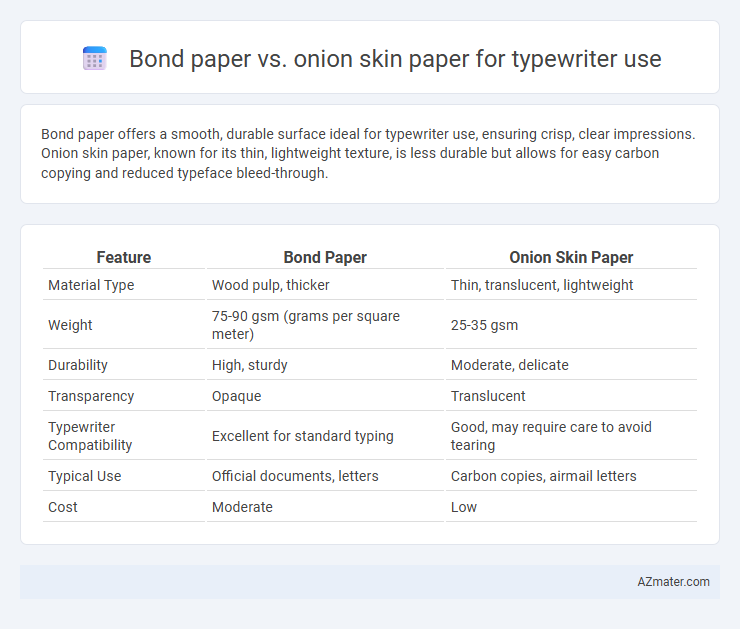Bond paper offers a smooth, durable surface ideal for typewriter use, ensuring crisp, clear impressions. Onion skin paper, known for its thin, lightweight texture, is less durable but allows for easy carbon copying and reduced typeface bleed-through.
Table of Comparison
| Feature | Bond Paper | Onion Skin Paper |
|---|---|---|
| Material Type | Wood pulp, thicker | Thin, translucent, lightweight |
| Weight | 75-90 gsm (grams per square meter) | 25-35 gsm |
| Durability | High, sturdy | Moderate, delicate |
| Transparency | Opaque | Translucent |
| Typewriter Compatibility | Excellent for standard typing | Good, may require care to avoid tearing |
| Typical Use | Official documents, letters | Carbon copies, airmail letters |
| Cost | Moderate | Low |
Introduction to Bond Paper and Onion Skin Paper
Bond paper is a durable, high-quality writing material commonly used for official documents and typewritten correspondence, characterized by its weight typically ranging from 16 to 24 pounds and smooth finish optimized for ink absorption. Onion skin paper, recognized for its ultra-thin, translucent texture and lightweight nature between 9 to 12 pounds, was popular for typewriters due to its ability to produce multiple carbon copies with minimal bulk. Both papers offer distinct advantages for typewriter use: bond paper provides durability and a professional feel, while onion skin balances lightweight convenience with effective ink transfer.
Historical Overview of Typewriter Paper Choices
Typewriter paper choices historically varied between bond paper and onion skin paper, each serving distinct purposes during the mid-20th century when typewriters peaked in use. Bond paper, known for its durability and smooth texture, was commonly used for official documents and correspondence, offering a professional appearance and resistance to ink bleed-through. Onion skin paper, lightweight and translucent, was favored for carbon copies and conserving paper resources, enabling efficient multi-copy typing with its thin, strong fibers.
Key Differences: Bond Paper vs Onion Skin Paper
Bond paper offers a heavier weight and smoother texture ideal for crisp, legible typewritten documents, while onion skin paper is much thinner and translucent, allowing multiple copies to be created with carbon paper. Bond paper typically ranges from 16 to 24 pounds per ream, providing durability and resistance to ink bleed, whereas onion skin paper weighs around 9 to 12 pounds, prioritizing lightness and flexibility. The choice between bond and onion skin paper impacts the permanence and clarity of typewriter output, with bond suited for formal documents and onion skin favored for bulk, multi-copy typing.
Texture and Thickness: Impact on Typing Experience
Bond paper offers a smooth and sturdy texture with medium thickness, ensuring crisp, clear typing impressions and reduced ink bleed-through on typewriters. Onion skin paper is ultra-thin and slightly translucent with a rougher texture, which can cause more typing noise and potential misalignment but allows for lighter, easier keystrokes. The choice between bond and onion skin paper significantly affects typing comfort, ink clarity, and document durability during typewriter use.
Durability and Longevity for Typed Documents
Bond paper offers superior durability and longevity for typed documents due to its thicker fiber structure and resistance to tearing and yellowing over time. Onion skin paper, while thinner and lighter, is more prone to wear and degradation, making it less ideal for preserving important typewritten records. For archival purposes, bond paper ensures that typed text remains intact and legible for extended periods under various environmental conditions.
Ink Absorption and Print Clarity Comparison
Bond paper offers superior ink absorption and print clarity for typewriter use due to its thicker, more porous surface that prevents ink bleed-through and smudging. Onion skin paper, being thinner and more translucent with a smoother texture, tends to allow more ink bleed, leading to less sharp print quality and potential show-through on the reverse side. For crisp, clear typewritten documents, bond paper remains the preferred choice given its enhanced ink retention and reduced feathering characteristics.
Carbon Copy Efficiency: Which Paper Performs Better?
Bond paper offers superior carbon copy efficiency compared to onion skin paper due to its thicker, more absorbent surface that captures carbon impressions clearly and prevents smudging. Onion skin paper, while thinner and lighter, often leads to weaker carbon copies because the delicate fibers absorb ink poorly, resulting in less distinct duplicate pages. For typewriter users prioritizing crisp and reliable carbon copies, bond paper is the better choice.
Handling, Storage, and Preservation Considerations
Bond paper, known for its durability and smooth surface, offers superior handling for typewriter use, minimizing wear and tear during typing and providing consistent print quality. It requires storage in a cool, dry environment to prevent moisture absorption and yellowing, ensuring long-term preservation without degradation. Onion skin paper, thinner and more delicate, demands careful handling to avoid tears and creases, with storage needing protective sleeves and controlled humidity to maintain its fragile integrity over time.
Cost and Availability in the Modern Market
Bond paper is widely available and cost-effective for typewriter use, making it the preferred choice for everyday documents. Onion skin paper, known for its thin and translucent quality, is more expensive and less commonly found in modern office supply stores. Both types suit typewriters, but bond paper dominates due to its affordability and easy accessibility.
Choosing the Right Paper for Typewriter Enthusiasts
Choosing the right paper for typewriter use hinges on durability and texture, with bond paper offering smooth surface quality and excellent ink absorption, making it ideal for crisp, clear typing. Onion skin paper, known for its ultra-thin, translucent nature, provides a lightweight option favored for multi-copy typing and easy handling but may require careful handling to avoid tears. Typewriter enthusiasts prioritize bond paper for everyday use due to its sturdiness and professional finish, while onion skin paper remains a niche choice for specific purposes like carbon copy creation and archival correspondence.

Infographic: Bond paper vs Onion skin paper for Typewriter use
 azmater.com
azmater.com